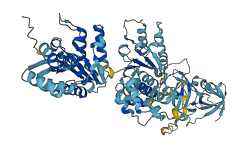Q0PF19
Gene name |
nsf.S |
Protein name |
Vesicle-fusing ATPase |
Names |
|
Species |
Xenopus laevis (African clawed frog) |
KEGG Pathway |
xla:779070 |
EC number |
|
Protein Class |
|

Descriptions
Autoinhibitory domains (AIDs)
Target domain |
252-399 (D1 domain) |
Relief mechanism |
Partner binding |
Assay |
|
Accessory elements
No accessory elements
Autoinhibited structure

Activated structure

0 structures for Q0PF19
| Entry ID | Method | Resolution | Chain | Position | Source |
|---|
No variants for Q0PF19
| Variant ID(s) | Position | Change | Description | Diseaes Association | Provenance |
|---|---|---|---|---|---|
| No variants for Q0PF19 | |||||
No associated diseases with Q0PF19
5 regional properties for Q0PF19
| Type | Name | Position | InterPro Accession |
|---|---|---|---|
| domain | CDC48, N-terminal subdomain | 5 - 86 | IPR003338 |
| domain | ATPase, AAA-type, core | 256 - 396 | IPR003959-1 |
| domain | ATPase, AAA-type, core | 539 - 668 | IPR003959-2 |
| conserved_site | ATPase, AAA-type, conserved site | 367 - 385 | IPR003960 |
| domain | AAA ATPase, AAA+ lid domain | 423 - 461 | IPR041569 |
1 GO annotations of cellular component
| Name | Definition |
|---|---|
| cytoplasm | The contents of a cell excluding the plasma membrane and nucleus, but including other subcellular structures. |
3 GO annotations of molecular function
| Name | Definition |
|---|---|
| ATP binding | Binding to ATP, adenosine 5'-triphosphate, a universally important coenzyme and enzyme regulator. |
| ATP hydrolysis activity | Catalysis of the reaction: ATP + H2O = ADP + H+ phosphate. ATP hydrolysis is used in some reactions as an energy source, for example to catalyze a reaction or drive transport against a concentration gradient. |
| metal ion binding | Binding to a metal ion. |
2 GO annotations of biological process
| Name | Definition |
|---|---|
| protein transport | The directed movement of proteins into, out of or within a cell, or between cells, by means of some agent such as a transporter or pore. |
| SNARE complex disassembly | The disaggregation of the SNARE protein complex into its constituent components. The SNARE complex is a protein complex involved in membrane fusion; a stable ternary complex consisting of a four-helix bundle, usually formed from one R-SNARE and three Q-SNAREs with an ionic layer sandwiched between hydrophobic layers. |
No homologous proteins in AiPD
| UniProt AC | Gene Name | Protein Name | Species | Evidence Code |
|---|---|---|---|---|
| No homologous proteins | ||||
| 10 | 20 | 30 | 40 | 50 | 60 |
| MAVRSMQAAR | CPTDELSISN | CAVVNEKDFQ | SGQHVNVRTS | PNHRYIFTVK | THHTILPGSI |
| 70 | 80 | 90 | 100 | 110 | 120 |
| AFSLPQRKWA | GLSIGQDVEV | GVYTFDKTKQ | CIGTMTIEID | FLQKKSIDSN | PYDTDRMAAE |
| 130 | 140 | 150 | 160 | 170 | 180 |
| FIQQFNNQAF | SVGQQLVFSF | NDKLFGLVLK | DIEAMDPSIL | KGEPSTGKRQ | KIEAGLVVGN |
| 190 | 200 | 210 | 220 | 230 | 240 |
| SQVVFEKADS | SSLNLTGKSK | TRQDRQSIIN | PDWNFEKMGI | GGLDKEFSDI | FRRAFASRVF |
| 250 | 260 | 270 | 280 | 290 | 300 |
| PPEIVEQMGC | KHVKGILLFG | PPGCGKTLMA | RQIGKMLNAR | EPKVVNGPEI | LNKYVGESEA |
| 310 | 320 | 330 | 340 | 350 | 360 |
| NIRKLFADAE | EEQRRLGANS | GLHIIIFDEI | DAICKQRGSM | AGSTGVHDTV | VNQLLSKIDG |
| 370 | 380 | 390 | 400 | 410 | 420 |
| VEQLNNILVI | GMTNRPDLID | EALLRPGRLE | VKMEIGLPDE | KGRLQILHIH | TARMREHSLL |
| 430 | 440 | 450 | 460 | 470 | 480 |
| SGDVDVGELA | QETKNFSGAE | LEGLVRAAQS | TAMNRHIKAT | TKVEVDMEKA | ECLQVTRGDF |
| 490 | 500 | 510 | 520 | 530 | 540 |
| FTSLGNDIKP | AFGTNQEDYA | SYIMNGIIKW | GDPVTRVLDD | GELLVQQTKN | SDRTPLVSVL |
| 550 | 560 | 570 | 580 | 590 | 600 |
| LEGPPHSGKT | SLAAKISEES | NFPFIKICSP | EKMIGFSETA | KCQAIKKIFE | DAYKSQLSCV |
| 610 | 620 | 630 | 640 | 650 | 660 |
| VVDDIERLLD | YVPIGPRFSN | LVLQALLVLL | KKAPPQGRKL | LIICTTSRKD | VLQEMEMLDA |
| 670 | 680 | 690 | 700 | 710 | 720 |
| FSTTIRVPNI | VTGEQLMEAL | ELLGGFKDNE | RSVIAQQVKG | KKVYIGIKKL | LMLIEMSMQM |
| 730 | 740 | ||||
| DPEYRVSKFL | ALLKEEATEP | VHRGYD |